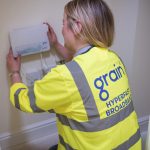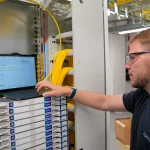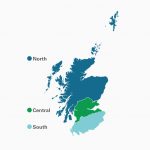Interview – BDUK CEO Talks FTTP, Council Broadband Maps and BT Competition
A lot has been said about the ups and downs of the Government’s national Broadband Delivery UK scheme, not least with regards to the lack of detailed coverage maps, BT’s dominance of the contract(s) and how the final gap of 5% will be closed. ISPreview.co.uk has today roped in the CEO of BDUK, Christopher Townsend, to answer some of the most common queries.
At present the £1.7bn programme is largely dominated by BT’s ‘up to’ 80Mbps capable Fibre-to-the-Cabinet (FTTC) technology and aims to make fixed line superfast broadband speeds (24-30Mbps+) available to 95% of the United Kingdom by 2017. Tentative plans are also being developed to tackle the final 5%.
Advertisement
The project has already helped to put an additional 1 million premises within reach of superfast connectivity and up to 40,000 extra homes and businesses are said to be gaining access each week (here). However, despite this progress, BDUK has also faced plenty of criticism.
Complaints tend to range from a concern over the lack of competition (BT dominates the contracts), limited transparency of costs, delays and a fear that the dominant FTTC technology might not be the best option for meeting the UK’s longer-term connectivity needs. Indeed many have campaigned for a true fibre optic (FTTP/H/B) network, although this is likely to have required billions of additional investment and would take many years longer to roll-out (note: BT are deploying a little FTTP).
But some of the complaints have also had a political dimension, such as the National Audit Office’s (NAO) assertion in June 2013 that the whole programme had fallen 22 months behind schedule. In fairness, the delay was probably a lot less and the NAO’s assertion seemed to be based off the fact that the scheme would now finish by the end of 2017 instead of 2015 as originally planned, although this ignores that the 90% target had also been lifted to 95% (BDUK still looks likely to reach around 90% in 2015).
Earlier this year the Government decided to address some of these concerns by re-organising BDUK around a more commercial focus for spending the next £250m of its budget (i.e. this is intended to help expand superfast coverage from 90% to 95%). Part of that involved the appointment of Christopher Townsend, a former Commercial Director of the London 2012 Olympics Organising Committee, to lead the project.
Advertisement
The BDUK Mini-Interview
Q1. As you will be aware a fair number of local councils have been reluctant to produce detailed broadband roll-out maps or publish the tentative post-code data for those down to the 7-digit postcode level, much to the annoyance of many ordinary people and the Public Accounts Committee (note: there are about 44 local authorities involved in the BDUK project).
Back in June 2014 we learnt that you intended to review council compliance on this matter “to see who is doing it and who is not” (here). Can you tell us what the outcome of that was and how BDUK intends to act, especially given that it’s ultimately a decision for local authorities and one that BDUK appears to have only limited influence over?
ANSWER:
I am keen that Local Authorities provide as much visibility as possible on the roll-out plans, and BT has also confirmed that it will not stand in the way of any local authorities publishing this information. 38 projects have now published detailed broadband rollout maps, 26 of these are to 7 digit level. I wrote to the others in July encouraging them to do likewise and we will continue to press this with the local authorities.
Q2. We note that BDUK’s £250m Superfast Broadband Extension Programme was supposed to be given a more commercial focus, although so far most of the local authorities seem to be extending their existing contracts with BT and under more or less the same apparent terms as before. What are you thoughts on this?
ANSWER:
We continue to work with local authorities to ensure they get good value for money from their projects. As part of this we are getting complete transparency of the costs of roll-out in the existing projects and we are confident that the programme will release significant savings which will allow for further investment. Regarding the new projects, local authorities can extend their existing contracts if this is possible within the scope of the procurement regulations, but otherwise they will need to enter into a new call-off contract from the broadband framework or undertake a new OJEU procurement. This is a decision for each local authority to take.
Q3. Can you clarify how BDUK’s focus and approach has changed since you came on-board earlier this year (i.e. what is it doing differently from the first round of £530m investment)?
Advertisement
ANSWER:
I have thoroughly reviewed BDUK’s approach and I believe that there is much that is already in place that is good and does not need to be subject to fundamental change. But it is important that we have the right relationships with our suppliers and that we are properly holding them to account. This is where I am focusing a lot of my efforts. We also need to support local authorities effectively so that they can get the best possible results from the investment that they are putting in.
Q4. The vast majority of BT’s involvement with the BDUK programme has involved the deployment of their ‘up to’ 80Mbps Fibre-to-the-Cabinet (FTTC) technology, although we note that some ultrafast 330Mbps capable Fibre-to-the-Premises (FTTP) has also been used in certain areas.
Sadly BT are often reluctant to talk about which areas and how many premises will be put within reach of their native FTTP service (not to be confused with Fibre-on-Demand for businesses). Would BDUK consider asking councils to be clearer in their deployment updates about which areas can expect to benefit from FTTP?
ANSWER:
The most important thing at the moment is that there is as much transparency as possible on which areas will get superfast upgrades. It would also be helpful to show which areas will benefit from FTTP as opposed to FTTC but I do not regard this as such a high priority at this point in time. I would not want to impose additional constraints on the suppliers’ choice of roll-out technologies.
BDUK’s procurement process has always been technology neutral and it is for suppliers to propose the solutions which they think will deliver the greatest amount of coverage for the funding which is available. In BT’s case they have focused largely on FTTC as this gives the potential for widespread coverage at relatively low cost.
Q5. Earlier this month the Communications Minister, Ed Vaizey, suggested that they’d be able to identify the amount of funding necessary to help plug the final 5% of the country with superfast broadband by looking at the results of their new £10m Innovation Fund and its 8 related pilot projects.
What are your thoughts on the fund and the expectation that a combination of those pilots, excluding Satellite (this cannot currently offer a viable and flexible ‘superfast’ service), might actually be able to reach the 100% coverage mark or will BT need to be called upon again?
ANSWER:
I think that everyone recognises that supplying broadband services to remote locations is extremely challenging both commercially and also technically, but I believe that the pilots are a clear demonstration of the government’s commitment to extend the reach as far as it can. My expectation is that a range of technologies will be required. The pilots are the opportunity to demonstrate the role that different technologies can play.
The intention is certainly that the pilots will inform options for taking superfast broadband beyond 95%.
Q6. Finally, the UK government has chosen to define superfast broadband as being able to deliver Internet download speeds of “greater than 24 Megabits per second”. Should we now consider raising this in order to match Europe’s definition of at least 30Mbps?
ANSWER:
Our definition requires a Next Generation Access infrastructure and the technologies being deployed have the capability of meeting the European definition. So I do not see a need to change our position on this.
Thanks kindly to Christopher Townsend for taking the time to engage with us on some of the most contentious issues.
Mark is a professional technology writer, IT consultant and computer engineer from Dorset (England), he also founded ISPreview in 1999 and enjoys analysing the latest telecoms and broadband developments. Find me on X (Twitter), Mastodon, Facebook, BlueSky, Threads.net and Linkedin.
« Swindon Council Agree to Deploy Superfast Broadband

















































Comments are closed